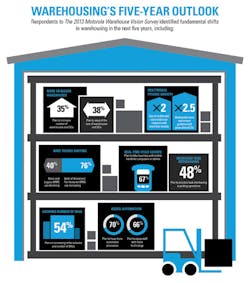Supply Chain & Logistics: Warehouses Are Evolving into High-Tech Fulfillment Centers
The push toward omni-channel distribution -- an all-encompassing supply chain strategy where retail stores are capable of fulfilling orders at any time from anywhere, and where manufacturers can function as their own retailers -- is leading to a surge in growth for warehousing technologies. And for many manufacturers, their interest in technology is shifting from basic cost-reduction strategies toward facilitating growth opportunities for their companies.
According to a "Future of Warehousing" study conducted by Motorola Solutions (IW 500/120), a manufacturer of communications technology, 26% of respondents (primarily manufacturers, retailers and wholesalers) view their warehouses and distribution centers (DCs) as an asset that can drive growth for the business. What's more, within the next five years, 35% say they plan to increase the number of warehouses and DCs they operate. By 2018, 66% of respondents plan to increasingly automate their distribution processes by equipping staff with new technology solutions.
See Also: Lean Supply Chain Logistics Best Practices
"Warehousing and distribution have not traditionally been the most celebrated functions within leading businesses across manufacturing, retail and wholesale industries," admits Mark Wheeler, director of warehouse solutions with Motorola Solutions. However, he notes, these functions are playing a more important role as manufacturers face increasing pressures to cut costs, enhance profitability and free up capital, all while driving competitive differentiation and business growth.
As warehouses take on more capabilities, so too has grown an interest in warehouse management systems (WMS), a basic supply chain software solution that controls, manages and regulates the movement of goods within a warehouse or DC. Last year, the global market for WMS tools grew by 8%, spurred largely by upgrades in mature industries, as well as the adoption of add-on modules and increased demand driven by the omni-channel distribution, according to ARC Advisory Group, a market research and advisory firm.
"Omni-channel retailers are integrating brick and mortar and e-commerce distribution channels," notes Clint Reiser, an analyst with ARC. At the same time, "traditional warehouses are being outfitted with WMS functionality to support the individual item handling requirements of e-commerce fulfillment."
Just as retailers are upgrading their WMS solutions to improve store-level accuracy to support order fulfillment, consumer goods manufacturers -- particularly branded apparel companies -- are looking to WMS technology to support their retail customers' integrated distribution initiatives, Reiser explains.
| Learn how and why Amazon and Walmart are changing the supply chain landscape at www.industryweek.com/blog/gaining-supply-chain-edge. |
As Bob Heaney, an analyst with Aberdeen Group, points out, the surge in holiday sales on Black Friday and Cyber Monday in recent years offers merely a hint as to what the emerging omni-channel marketplace will require from retailers and manufacturers.
About the Author
Dave Blanchard
Senior Director of Content
Focus: Supply Chain
Call: (941) 208-4370
Follow on Twitter @SupplyChainDave
During his career Dave Blanchard has led the editorial management of many of Endeavor Business Media's best-known brands, including IndustryWeek, EHS Today, Material Handling & Logistics, Logistics Today, Supply Chain Technology News, and Business Finance. He also serves as senior content director of the annual Safety Leadership Conference. With over 30 years of B2B media experience, Dave literally wrote the book on supply chain management, Supply Chain Management Best Practices (John Wiley & Sons, 2010), which has been translated into several languages and is currently in its second edition. He is a frequent speaker and moderator at major trade shows and conferences, and has won numerous awards for writing and editing. He is a voting member of the jury of the Logistics Hall of Fame, and is a graduate of Northern Illinois University.

